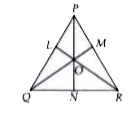If ΔABC~ΔPQR with BCQR=13,then ar(ΔPRQ)ar(ΔBCA) is equal to
A
9
B
3
C
13
D
19
Video Solution
Text Solution
The correct Answer is:A
|
Answer
Step by step video, text & image solution for If DeltaABC~DeltaPQR with (BC)/(QR)=1/3,then (ar(DeltaPRQ))/(ar(DeltaBCA)) is equal to by Maths experts to help you in doubts & scoring excellent marks in Class 10 exams.
Updated on:21/07/2023Topper's Solved these Questions
- TRIANGLESBOOK - EDUCART PUBLICATIONCHAPTER - TRIANGLESEXERCISE - OBJECTIVE TYPE QUSTIONS (FILL IN THE BLANKS)
11 Videos
- TRIANGLESBOOK - EDUCART PUBLICATIONCHAPTER - TRIANGLESEXERCISE - VERY SHORT QUESTIONS
10 Videos
- SURFACE AREAS AND VOLUMESBOOK - EDUCART PUBLICATIONCHAPTER - SURFACE AREAS AND VOLUMESEXERCISE - LONG ANSWER TYPE QUESTIONS
30 Videos
Similar Questions
Knowledge Check
It is given that ΔABC−ΔPQR, with BCQR=14. Then arΔPQRarΔABC is equal to:
A16B3C13D19It is given that ΔABC~ΔPRQandBCQR=23 then ar(ΔPQR)ar(ΔABC)=?
A23B32C49D94If △ABC - △PQR and BCQR = 14 then ar(△PQR)ar(△ABC) =
A14B41C116D161
If ΔABC~ΔPQR,ar(ΔABC)ar(ΔPQR)=169,AB=2cm and AC= 12 cm, then find the value of PR.
View SolutionIn ΔABC,AD is the bisector of ∠A . Then , ar(ΔABD)ar(ΔACD)=
View SolutionIf in two ΔABC and ΔPQR, ABQR=BCPR=CAPQ, then
View SolutionIn ΔABC, D and E are points on AB and AC respectively such that DE is parallel to BC. If AD= 2 cm, BD = 3 cm, then ar(ΔADE)ar(ΔABC) is
View SolutionLet ΔABC~ΔPQRandar(ΔABC)ar(ΔPQR)=425. If AB=12cm,BC=8cmandAC=10cm then QR is equal to
View Solution

